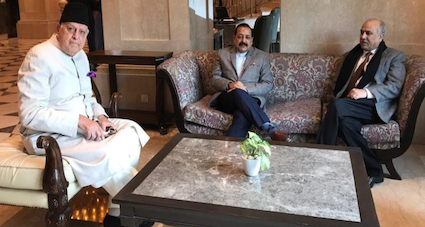Disappointing is the first word that came to mind on hearing that the Delimitation Commission has indicated that it is going to propose 43 seats for the Jammu region, and 47 for Kashmir. On Monday, the commission headed by Justice (retired) Ranjana Prakash proposed this division. The commission shared its first draft in Delhi with associate members drawn from the National Conference and the BJP. The members who participated in the meeting were NC chief Farooq Abdullah, Hasnain Masoodi, Jitendra Singh (MoS in PMO) and Jugal Kishore Sharma, all Lok Sabha MPs from Jammu and Kashmir.
As expected, Singh termed the commission draft as “objective’’ but almost the entire spectrum of Kashmir-based parties termed it as unacceptable. Those who outright rejected the report included NC second in command Omar Abdullah, PDP chief Mehbooba Mufti, People’s Conference chief Sajad Lone and Apni Party chief Altaf Bukhari. Interestingly, newly appointed UT Congress chief Raman Bhalla said that increasing the number of seats by six in Jammu is no enough. He asserted that this was less than just, meaning thereby that the number of seats in Jammu should have gone up.
In the 87-member legislative assembly before August 5, 2019, the Kashmir region had 46 seats while the Jammu region had only 37 seats. Another four seats were in the Ladakh region which has now become a separate Union Territory (UT) after it was hived off from erstwhile state of Jammu and Kashmir. At the time of scrapping of Article 35-A and whittling down Article 370, a fresh delimitation of assembly seats was also ordered. The Central government had raised the number of assembly seats from 83 to 90. It had also asked that Scheduled Tribes (STs) be given reservation in the political sphere as they were denied this right given to them by the Constitution of India so far.
The commission has proposed that the STs be given nine reserved seats and the Scheduled Castes (SCs) seven, as was earlier the case. It is not clear which nine seats will be reserved for the STs, nor is it which seats will be reserved for the SCs. It needs to be mentioned here that seven reserved SC segments need to be rotated, as per the constitutional scheme of things. During 1996, 2002, 2008 and 2014 assembly elections, seven seats were reserved for SCs and it is likely that most of these seats will be changed. Meaning thereby that some new seats will be kept as reserved seats for SCs and some old SC reserved seats will be changed.
In the days to come, one can expect that political temperature will rise significantly even as mercury plunges all across J&K. Some days ago, the PDP had said that it had no faith in the commission appointed by the BJP government. The NC had said it would accept the commission recommendations only if these were unbiased and based on data of 2011 census according to which the population of Kashmir valley is 15 lakh more as compared to the Jammu region. However, it has been repeatedly alleged by several Jammu-based leaders that the census figures were grossly fudged. They had also said that delimitation should be undertaken only after a fresh census. They had also suggested that Central rule should continue in J&K till such time as a new census was completed.
In the days to come, more details from the commission regarding its draft may emerge and shed some light on the process or variables of Representation of People’s Act, 1951, it followed while giving its recommendations. In RPA, 1951, population, means of communication, terrain, connectivity and like considerations are some of the variables which are taken into account when delimiting the constituencies.
The Kashmir region is spread over 15,948 square kilometres as compared to the Jammu region spread over 26,293 square kilometres. In 2014, the average geographical size of an assembly segment was 345 square kilometre and in Jammu 711 square kilometre. If the commission’s new recommendations really turn into a reality, the average size of an assembly segment in Kashmir will be 339 sq km (15,948/47= 339) and that in Jammu 611 sq km (26,293/43=611).
In terms of voters, there were 10 assembly segments in Jammu with over 1 lakh voters and only four in Kashmir. The 10 largest assembly segments in Jammu were 1. Gandhi Nagar (1,68,643 voters) 2. Jammu West (1,53,540 voters) 3. Rajouri (1,13,757 voters) 4. Kathua (1,12,083 voters) 5. Vijaypur (1,08,124 voters) 6. Ram Nagar (1,07,952 voters) 7. Reasi (1,07,916 voters) 8. Hiranagar (1,06,657 voters) 9. Udhampur (1,05,880 voters and 10. Bhaderwah (1,04,631 voters). The largest assembly segments in Kashmir were 1. Batmaloo (1,20,339 voters) 2. Kupwara (1,06,807 voters) 3. Sopore (1,03,782 voters) 4. Budgam (1,03,634 voters) and 5. Hazratbal (99,850 voters, less than 100,000 voters).
Going by the first draft of the Delimitation Commission, it doesn’t look likely that even after allocating six more seats to the Jammu region, the gross disparities with Kashmir will get addressed. This is clear from a perusal of the preceding few paragraphs.
Sant Kumar Sharma, a seasoned journalist, is an authority on Jammu and Kashmir. Two of his books on Article 370 and Delimitation are already out. The third one on Indus Waters Treaty is now out and could be bought here.
Sant began as a teacher but after six years, joined the Indian Express, Chandigarh in 1990, the year when terrorism was taking its first step in J & K and soon there would be exodus of lakhs of Kashmiri Pandits from the Valley. He subsequently worked for The Statesman, The Times of India and Star News among others. He is based in Jammu since May 2000.
He edits epaper.earthnews.in, a newspaper from Jammu presently.


